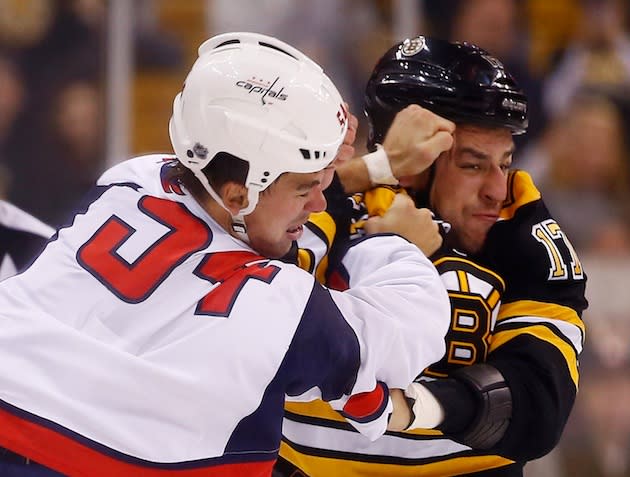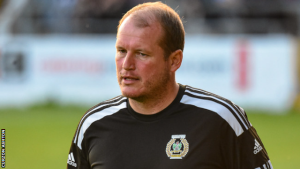

After taking a blow, Marcus Foligno of Minnesota countered with a blow of his own to Jarred Tinordi of Chicago, and the two large men exchanged blows.
It took even less time for Matt Rempe and Matt Martin to add some spice to the Rangers vs. Islanders game by getting into a brawl in front of 82,000 fans outside at the Meadowlands.
when Ridly Greig was cross-checked by Morgan Rielly for slapping a shot into an empty net? A little shoving and pushing. Not a thing more.
50-year-old retired player Todd Simpson questioned why there wasn’t a fight, saying he didn’t know how everyone didn’t start fighting in 580 NHL games.
Simpson racked up more than 1,300 penalty minutes. “There ought to have been a major brawl.”
These incidents, all of which occurred in the last month alone, serve as compelling reminders that fighting in the NHL is still going strong despite numerous reductions.
Twenty years have passed since Simpson and his Ottawa teammates engaged in a brawl at Philadelphia, a game that still holds the NHL record for the most penalty minutes (419), which was a shocking event.
23 players out of 40 who line up received at least two minutes of extra time. Many received significantly more.
Massive fights like that have long since faded, much like the blood and cheap shots in “Slap Shot.” But just like the well-loved film, many gamers still remember and even crave fighting, and they still like watching the fights.
Fans should not fear, though, since fighting is still prevalent in the NHL, despite the league’s decreasing number of goon places.
Roughly every four to five games, a fight breaks out in the league.
Even though they have seen some of the greatest fighters become shells of their former selves after taking repeated hits to the head, many believe it has a permanent place in a sport that emphasizes sticking up for comrades.
Although it doesn’t occur frequently, it’s still necessary, according to Vancouver Canucks coach Rick Tocchet,
whose 237 career fights are ranked 21st all-time. “You could truly use as intimidation when I performed.
Not as much, but still somewhat, can be used nowadays. Staging fights and other such acts is no longer effective. However, there is a place and time for it.
The NHL does not make available a list of all penalties, including those for significant infractions like fighting.
As of Monday, 219 fights have taken place this season; another 63 are expected before the playoffs start, for a total of 282, a significant decrease from the 789 in 2003–04.
This information is sourced from HockeyFights.com. That represents a dramatic decline from 645 as recently as 2010–11 and a 200% drop over the previous 20 years.
One of the reasons is the changes in rules. It became more challenging for a team to afford a player whose abilities were restricted to punching out and shielding stars when the wage cap was implemented in 2005.
In 2013, obligatory visors were grandfathered in and it became unlawful to fight without a helmet.
One-dimensional fighters like myself from the past are certainly extinct, according to Riley Cote, who competed 50 times in 156 games with Philadelphia from 2007 to 2010 in addition to numerous additional times in the minor leagues.
It was a logical development. While I doubt the NHL will ever completely phase it out, they are certainly making a decent effort.
Nobody anticipates a fighting prohibition, such as the international and college expulsion and suspension procedures. According to NHL Commissioner Gary Bettman, fighting prevents hostilities from blowing up.
According to Bettman’s 2013 statement, “fighting, in the spontaneous sense, tends to act as a bit of a thermostat when things happen during the game.”
“I’d rather them be punching each other rather than swinging sticks at each other,” Bettman stated in reference to a brawl between Vincent Lecavalier and Jarome Iginla.

CAN FIGHTING EXIST?
According to a 2011 NHL Players’ Association and CBC survey, 98% of players at the time opposed the outright ban on fighting.
Many of those guys are no longer in the league; their position has been taken by a new generation of players who have made hockey faster and more skilled than before, but who are still willing to drop the gloves when necessary and crave that freedom.
Brayden Schenn, the captain of the St. Louis Blues, who has fought twice this season but never more than four times a year as a professional, stated that “it always needs to be in the game.
” “If you’re going to run around and make a big hit, you have to understand that sometimes you’re going to have to deal with the consequences. You need guys to police it themselves.”







